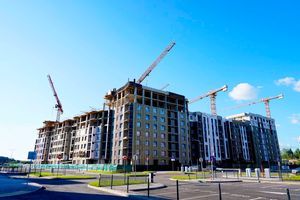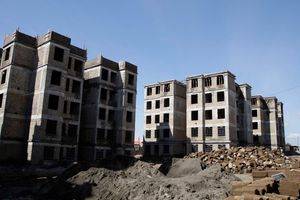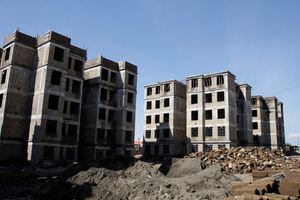
Residents living in some parts of Nairobi are reporting health complications linked to the period they spend in certain buildings.
Over the past decade, as younger generations have moved from their home counties to Nairobi in search of better lives, the demand for low-cost housing within and around the city has grown significantly.
This demand has seen developers and investors shift their focus from niche asset classes such as commercial, land, hospitality and mid to high-end residential, to the affordable housing category. But with affordable housing units going for lower rates than units in other asset classes, some developers have resorted to cutting corners to maintain their profit margins.
From using substandard construction materials, to hiring unqualified personnel and flouting building regulations, these developers have capitalised on industry gaps to reduce the cost of construction.
“The end goal for a developer is to make money. If not properly regulated, they could easily put up buildings that fall short,” said Stephen Lutta, an architect with Bomani Consulting Group.

Stephen Lutta, architect, Bomani Consulting Group.
According to the Nairobi County Government, an alarming 60 percent of the buildings coming up in Nairobi are not fit for occupation, because the developers are not complying with set guidelines.
This omission is resulting in the ‘sick building syndrome’, where residents living in some parts of Nairobi are reporting health complications linked to the period they spend in certain buildings.
“You may have heard people complain about feeling unwell when they are at home, when they go away for a few days, they feel better, only for them to feel unwell again once they return,” Lutta points out.
Those most affected by this phenomenon are the people who experience chronic health conditions such as asthma, as well as babies, who inevitably spend a lot of time indoors.
“If the main living room in an apartment is directly opposite another building, then definitely the occupants are going to have health-related problems because that's where they spend most of their time,” said Lutta.
The architect, who is also an official at the Architectural Association of Kenya, says that many of the buildings in Nairobi do not follow the physical and land use planning act.
The act, which provides a framework for the planning, use and regulation of land in Kenya, aims to ensure sustainable and orderly development of real estate at the national and county levels.
“What has led to the proliferation of sick buildings is neglect of plans. An area like Pipeline for instance that’s meant to be industrial, is residential, hence the issues with water and drainage,” stated Lutta.
Chris Ochieng’, the CEO of Gulf Cap Real Estate Company, says that failing to abide by the set guidelines could have a negative impact on the returns for developers, as this affects the rate of occupancy.

Chris Ochieng', CEO of Gulf Cap Real Estate, at the company's housing project in Starehe, Nairobi.
“For instance, while it may appear more lucrative on paper to have as many units as possible on each floor, leaving little to no green space in an apartment may in the long run lead to lower occupancy,” said Ochieng'.
This is because the modern home buyer is more exposed and well-informed on the kinds of spaces that would be suitable and beneficial to their health and well-being.
“A statement that designers commonly hear from clients is ‘I want big windows.’ Even if they may not be aware of the term, these people are simply asking for sustainable developments,” posed Ochieng'.
The benefits of delivering such projects are significant, with data revealing that buyers are willing to pay 6 percent more in rent for buildings that are naturally lit, cross ventilated and accessible to people living with disabilities.
“When tenants notice that their apartment block has an issue, they tend to discuss among themselves. Some then vacate to other projects, leaving the owner grappling with vacant units,” said Ochieng'.
In addition to improved marketability, the engineer says that developers stand to benefit from funding from financial institutions that tend to give preferential treatment to developers who adhere to sustainable building practices.
“Sustainable projects enable real estate developers to access finance via instruments such as green bonds that are subject to tax incentives and lower interest rates,” said Ochieng'.
These bonds not only provide developers with access to suitable financial products for profitable construction, but also enhance a company's reputation as a socially responsible organisation.

Substandard buildings have often been discovered to have been put up by inexperienced and unregistered persons masquerading as professionals.
Sustainable building practices also safeguard the property from devaluation over time, ensuring that even those who inherit the property get to benefit from good rental yields and capital gains.
“When you uphold the leasehold value of a property, investors will certainly be attracted to it because they know they can generate value for an extended period of time,” stated Ochieng’.
The Architectural Association of Kenya has developed a healthy homes checklist that can be used to certify whether or not a particular building adheres to sustainable building practices.
Healthy home checklist
Brenda Nyawara, the Vice President of AAK, explains that the checklist details how professionals can prioritise the health of the people living in buildings, in accordance with the building regulations in Kenya. Under the guidelines, developers can, for instance, take advantage of natural ventilation by selecting sizable window types that direct or avert airflow into the house. Orienting windows and doors on adjacent or opposite walls and in the direction of the cool breeze could enable air to flow freely into and out of the house.
“Besides health and well-being of the occupants, buildings that incorporate natural lighting and ventilation offer 15 to 40 percent energy savings,” says Nyawara.
This is particularly handy in the tropics, where temperatures do not rise or drop to extreme levels, making it an unnecessary burden on occupants to have to use air conditioning. Applying reflective paint on tin roofs, insulating the roof using dry papyrus reeds or using cellulose boards as ceiling, can ensure the roof reflects more solar radiation and absorbs less heat.
The guidelines also stipulate that water systems must be well separated from sewerage systems to avoid contamination. Water supply should also be enough to sustain the whole household consistently, as recommended by the World Health Organisation (50-100 liters per person everyday).
Pit latrines and soak ways should be at least 30 metres from a groundwater source while the bottom of the latrine should be at least 1.5 metres above the water table. There should be a designated waste collection point no more than 100 metres from households, with solid waste collection being done at least twice every week.
The checklist also outlines the ideal materials for construction, such as the ones approved by the Kenya Bureau of Standards (KEBS) and the Green Building Council.
“Building materials can cause health issues for occupants. Over time, cement that is not mixed with clean water can for instance react negatively because the chemicals didn’t mix as required,” explains Nyawara.
Certain types of paints and varnishes also, have been known to contain volatile organic compounds (VOCs), that turn into toxic gases upon contact with the atmosphere.
“When these paints begin to peel off due to the chemical reactions, they turn into dust, which residents breathe in, and after a while start to develop health complications,” remarks Nyawara.
Elements such as asbestos and lead in some materials can affect the nervous, reproductive and digestive systems, resulting in skin, blood, kidney, memory, concentration, muscle, joint and eye problems.
Using locally available construction materials such as earthen bricks and timber, can not only prevent these health complications, but also boost the allure of the buildings.
“Professionals can help one identify what’s best for construction. Unfortunately, people often hire those who may not understand designs, materials and techniques that uphold quality,” said Michael Mathenge, Architect and Secretary, AAK Architects Chapter.
Eager to cut on costs, the architect says that developers often hire unqualified artisans to perform a job that requires specialised knowledge and expertise.
“Cheap can be expensive when it comes to construction. The consultants are the voice of the buildings, and when they are not heard, the consequences can be dire,” Mathenge points out.
The AAK estimates that 80 percent of buildings in the country are built without the input of professionals. Most of these buildings often fail to meet the minimum standards of a healthy home.
“Buildings that are substandard have often been discovered to be put up by inexperienced and unregistered persons masquerading as professionals. A qualified professional will consider all the factors that will affect the quality of the building,” says Mathenge.
He urges authorities to ensure that developers work with registered professionals, to avoid flouting of regulations meant to safeguard the lives of residents and prevent development of unapproved plans.
“We have seen cases where developers submit certain proposals but build something completely different. This can be prevented by professionals who are required to supervise construction as per the approved designs,” notes Mathenge.
Chris Ochieng concurs, adding that from the onset, authorities such as the county government and National Construction Authority (NCA), need to make sure that building plans are followed, to avoid the politics that comes with correcting existing buildings.
“Regulation should not be politicised, it should be research-based, but at times it can be difficult for elected leaders to bring down buildings that flout regulations, knowing that this could affect their political standing,” said Ochieng'.
Frequent inspections
Addressing issues before the construction is done not only manages the politics, it also manages the costs and ensures a successful integration with the building design and space layout.
“Authorities should ensure building plans account for natural lighting and ventilation into every unit of the development, by observing the setbacks of the piece of land and allowing for space between neighbouring buildings,” notes Ochieng'.
This can also be achieved by following the required plot ratio and ground coverage limitations, which determine how high a building can go and influences how well lower floors and neighbouring plots are lit or ventilated.
“For example, if the building covers 60 percent of land, the developer should allocate the 40 percent to green space, to allow more sunlight into spaces. This assessment can be conducted before issuing of building permits,” remarks Ochieng'.
Brenda adds that authorities such as the County Planning and National Environment Management Authority (NEMA), should conduct frequent inspections on sites, to curb malpractice and uphold best practices.
“If after inspection the buildings constructed are seen to pose a risk to the health of occupants, the authorities should refrain from issuing occupation certificates until they ensure compliance,” she says.
She adds that authorities can also consider inspecting premises before issuing business operation permits.
Adding his voice to the discussion, Lutta says that authorities such as the Kenya Bureau of Standards should boost their checks on imported materials, to contain the use of harmful products in construction.
“In trying to save on costs, some people import cheaper materials from abroad, which may contain harmful components. The effect is not always felt immediately. Cement for instance takes up to six years to set,” he says.
Mathenge is of the opinion that at the grassroot level, public awareness needs to be conducted to educate unsuspecting buyers and tenants of developments and practices that could endanger their lives and livelihoods.
“Building regulations and the role of professionals need to be simplified into understandable language, then disseminated in various media to reach as many people as possible,” says Mathenge.










